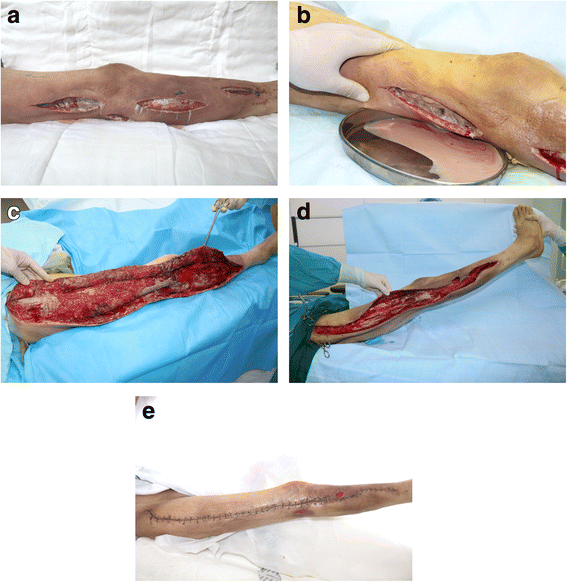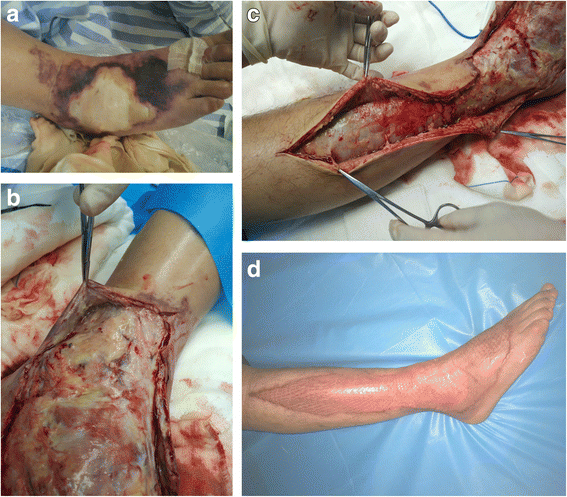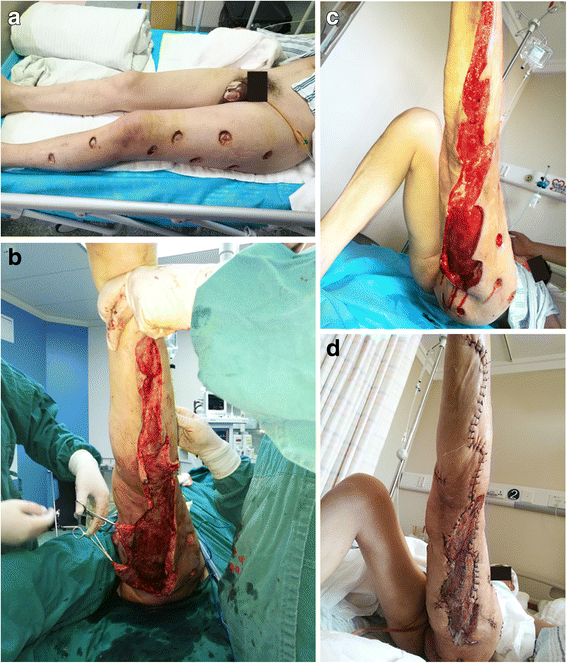Necrotizing soft tissue infection: clinical characteristics and outcomes at a reconstructive center in Jilin Province
- PMID: 29281989
- PMCID: PMC5745726
- DOI: 10.1186/s12879-017-2907-6
Necrotizing soft tissue infection: clinical characteristics and outcomes at a reconstructive center in Jilin Province
Abstract
Background: To investigate the clinical characteristics and treatment outcomes in necrotizing fasciitis (NF) patients in a reconstructive unit in northeastern China.
Methods: Medical records of patients diagnosed with and treated for NF in the extremities from November 2013 to December 2016 were retrospectively reviewed. Demographic data, clinical presentation, duration of signs and symptoms, location of infection, predisposing factors, causative microbiological organisms, laboratory risk indicator for necrotizing fasciitis (LRINEC) score, number of surgical debridements, length of hospital stay, treatments, and outcomes were recorded.
Results: A total of 39 consecutive patients were treated for severe NF (32 male and 7 female). Diabetes mellitus and blunt trauma were the most common risk factors (13 and 9 cases, respectively). The positive predictive value of the LRINEC score in NF diagnosis was 46.2%. Mean duration of signs and symptoms was 4.6 days. Staphylococcus aureus was the most commonly isolated bacteria (20 cases). All patients underwent their first debridement within 12 h of presentation (mean, 4.6 h). Mean number of surgical treatments was 2.8 (range, 2-5) per patient, including debridements. All patients survived, and mean length of hospital stay was 30.81 (range, 21-43) days. Three patients underwent limb amputation.
Conclusions: In our clinical experience, early detection and aggressive debridement are the cornerstones of NF treatment. Antibiotic therapy and intensive care support is essential in severe cases of NF. Anaerobic tissue culture and frozen section biopsy could be adopted as routine tests for diagnosis and decision-making in NF. These findings should inform clinical decisions about the treatment of individual patients with NF.
Keywords: Extremity; Necrotizing fasciitis; Surgical debridement; Treatment.
Conflict of interest statement
Ethics approval and consent to participate
This study was reviewed and approved by Institutional Review Board of the First Hospital of Jilin University. Informed written consent to participate was obtained through direct conversation with patients preoperatively. If the patient lacked the ability to give consent, we obtained it through direct conversation with the patient’s legal guardian. The legal guardian gave consent on behalf of the patient. All the records were anonymized.
Consent for publication
Informed written consent for publication of their clinical details and/or clinical images was obtained from the patient/guardian/relative of the patient.
Competing interests
The authors declare that they have no competing interests.
Publisher’s Note
Springer Nature remains neutral with regard to jurisdictional claims in published maps and institutional affiliations.
Figures



Similar articles
-
Laboratory Risk Indicator for Necrotizing Fasciitis score for early diagnosis of necrotizing fasciitis in Darwin.ANZ J Surg. 2018 Jan;88(1-2):E45-E49. doi: 10.1111/ans.13895. Epub 2017 Mar 15. ANZ J Surg. 2018. PMID: 28296037
-
The Laboratory Risk Indicator for Necrotizing Fasciitis score for discernment of necrotizing fasciitis originated from Vibrio vulnificus infections.J Trauma Acute Care Surg. 2012 Dec;73(6):1576-82. doi: 10.1097/TA.0b013e318270d761. J Trauma Acute Care Surg. 2012. PMID: 23188248
-
Characteristics and differences in necrotizing fasciitis and gas forming myonecrosis: a series of 36 patients.Scand J Surg. 2012;101(1):51-5. doi: 10.1177/145749691210100110. Scand J Surg. 2012. PMID: 22414469
-
Necrotizing fasciitis: a deadly infection.J Eur Acad Dermatol Venereol. 2006 Apr;20(4):365-9. doi: 10.1111/j.1468-3083.2006.01487.x. J Eur Acad Dermatol Venereol. 2006. PMID: 16643131 Review.
-
Necrotizing soft tissue infections: a primary care review.Am Fam Physician. 2003 Jul 15;68(2):323-8. Am Fam Physician. 2003. PMID: 12892352 Review.
Cited by
-
[Necrotizing fasciitis of the extremities and trunk].Chirurg. 2020 Apr;91(4):301-306. doi: 10.1007/s00104-019-01082-w. Chirurg. 2020. PMID: 31834420 Review. German.
-
Necrotizing fasciitis and meningitis due to Streptococcus pneumoniae serotype 9 N: a case report.BMC Infect Dis. 2019 Apr 29;19(1):358. doi: 10.1186/s12879-019-3969-4. BMC Infect Dis. 2019. PMID: 31035964 Free PMC article.
-
Clinical parameters and outcomes of necrotizing soft tissue infections secondary to gastrointestinal fistulas.BMC Infect Dis. 2019 Jul 9;19(1):597. doi: 10.1186/s12879-019-4248-0. BMC Infect Dis. 2019. PMID: 31288746 Free PMC article.
-
Role of Procalcitonin for Early Discrimination Between Necrotizing Fasciitis and Cellulitis of the Extremities.Cureus. 2024 Apr 5;16(4):e57668. doi: 10.7759/cureus.57668. eCollection 2024 Apr. Cureus. 2024. PMID: 38707041 Free PMC article.
-
Traditional herbal treatment induced bilateral amputation of the feet in a five-year-old child: A case report.Int J Surg Case Rep. 2020;70:110-114. doi: 10.1016/j.ijscr.2020.04.062. Epub 2020 May 11. Int J Surg Case Rep. 2020. PMID: 32416479 Free PMC article.
References
MeSH terms
LinkOut - more resources
Full Text Sources
Other Literature Sources

